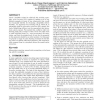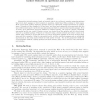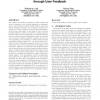173 search results - page 4 / 35 » Learning to rank networked entities |
ML
2010
ACM
13 years 4 months ago
2010
ACM
Scientific literature with rich metadata can be represented as a labeled directed graph. This graph representation enables a number of scientific tasks such as ad hoc retrieval o...
IIR
2010
13 years 7 months ago
2010
Given a classifier trained on relatively few training examples, active learning (AL) consists in ranking a set of unlabeled examples in terms of how informative they would be, if ...
KDD
2004
ACM
14 years 6 months ago
2004
ACM
Information retrieval systems, based on keyword match, are evolving to question answering systems that return short passages or direct answers to questions, rather than URLs point...
CIKM
2010
Springer
13 years 4 months ago
2010
Springer
We consider the problem of learning to rank relevant and novel documents so as to directly maximize a performance metric called Expected Global Utility (EGU), which has several de...
ICML
2005
IEEE
14 years 7 months ago
2005
IEEE
We investigate using gradient descent methods for learning ranking functions; we propose a simple probabilistic cost function, and we introduce RankNet, an implementation of these...



